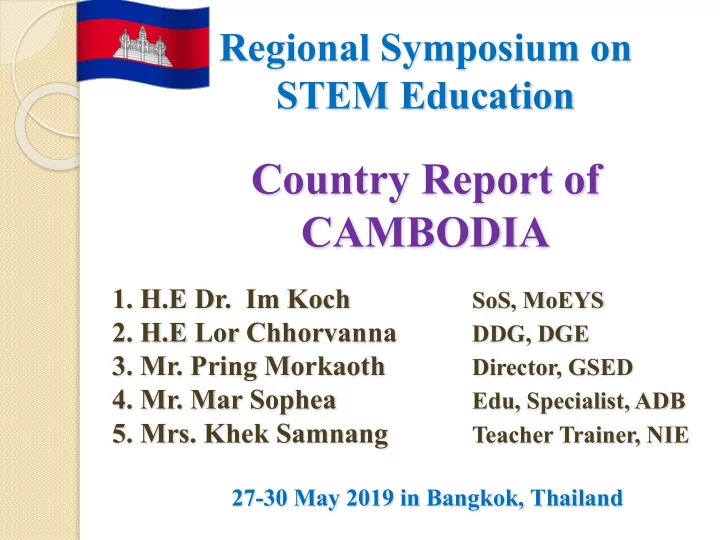

Regional Symposium on STEM Education Country Report of CAMBODIA 1. H.E Dr. Im Koch SoS, MoEYS 2. H.E Lor Chhorvanna DDG, DGE 3. Mr. Pring Morkaoth Director, GSED 4. Mr. Mar Sophea Edu, Specialist, ADB 5. Mrs. Khek Samnang Teacher Trainer, NIE 27-30 May 2019 in Bangkok, Thailand
Location of Cambodia Cambodia is located in Southeast Asia. It shares borders with Vietnam to the east, Laos to the North, Thailand to the west, and the ocean coast to the Southwest. The capital city of Cambodia is Phnom Penh . The total area is 181, 035 square kilometers.
1. General Information Country CAMBODIA Population size 16.48 million (May 18, 2019) Size of K-12 population 4,318,093 (F: 2,091,922) Main language of Instruction Khmer Main foreign language (s) taught English or French Schooling survival rate 70.32% Schooling gender ratios 1.24 (2018-2019) Teacher-student ratios 34.0 (2018-2019)
2. STEM Curriculum - Our Curriculum has been conducting STEM since 2018 - In Lower Secondary School (Grade 7 to 9) - Primary, Lower secondary, and upper secondary’s curriculum has been revised in 2018 - It will introduce in 2020
2. STEM Curriculum (Cont.) Curriculum innovation: Ø New Generation School (sister coding, parent night show,…) Ø National Institute of Education (NIE) (science fair) Ø Third STEM AEAN Robotics competition in Indonesia Ø Automatic water irrigation system in modern agriculture in Takeo
2. STEM Curriculum (Cont.) - Schools are lacked of laboratory, materials to conduct experiment, computers, and electricity. - ICT teachers do not teach at rural area - STEM curriculum is not conducting yet at primary school
2. STEM Curriculum (Cont.) - STEM curriculum should conducting at primary school first, then move toward lower Secondary school and upper secondary school 7
3. Teachers (K-12) T otal number of T eachers 112, 769 (2018-2019) F: 54,341 % of teachers with Master’s Degree 1 % and above % of teachers with a Bachelor’s Degree 16.23% % of teacher with less than a Bachelor’s Degree 66.46% % of teachers teaching at least one STEM subject (i.e. Science, N/A Engineering, Technology, Mathematics)
3.1 Teachers Training Programs No Level Numbers Duratio of TTCs n 1 Pre- school Teacher Training 2 Years 01 Center (PSTTC) 2 Provincial Teacher Training 16 2 Years Colleges/Centers (PTTCs) 3 Regional Teacher Training 04 2 Years Centers (RTTCs) 4 Teacher Education Colleges 02 4 Years (TECs) 5 National Institute of Education 01 1 Year (NIE)
3.1 Teachers Training Programs (Cont.) T eacher T eachers Training T eachers Training Programs Training Centers PSTTC Produces kindergartens v Trainees passed grade 9 and teachers failed grade 12 in disadvantage areas. PTTCs Produces Primary School v They passed grade 12 in urban Teachers areas v They must train for 2 years at PSTTC. RTTCs Produces Lower v They must pass grade 12 Secondary School Teachers v They must train 2 years at RTTCs TECs Produces Primary School v They must pass grade 12 and Lower Secondary v They must train 4 year at TECs School Teachers NIE Produces Upper v They must obtain Bachelor’s Secondary School Teachers Degree v They must train 1 year at NIE 10
3.2 Future Direction of Teacher Training Program v Two RTTCs and PTTCs have been upgraded to TECs by formula 12 + 4 in 2018 v From 2020, PSTTCs, PTTCs, and RTTCs will upgrade from 12+2 to 12+4 v From 2020, NIE will upgrade from BA+1 to M+1
3.3 Strengths of Teacher Training Program ü Criteria for teacher recruitment has been improved. ü Most of NIE teacher trainers graduated master degrees. ü 56 teacher trainers of TECs have been trained for master’s degrees. ü Upgrading Lower Secondary School Teachers by fast truck program (2 years) ü STEM curriculum has been applied to TTCs
3.4 Weaknesses of Teacher Training Program ü NIE will upgrade to M+1 in 2020 but most of Teacher Trainers hold only Master degrees ü No accreditation system for the training (no motivation) ü High rate of teacher movement (quality is not solved)
3.5 Specifics Programs ü NIE’s trainees will produce teaching materials to show their achievement during the science fair on the beginning of July ü MoEYs will celebrate the science fair every year and encourage teachers and student to join.
3.6 Professional Development ü Teachers join in-service training related to their major ü Teachers upgrade themselves by studying Bachelor and Master degrees. ü Teacher trainers join the short course training, seminar, and workshop relevant to their major.
3.7 Obstacle to teach STEM ü Teaching and learning materials are still lacking ü Some school do not have laboratory ü Some teachers cannot use ICT ü Lack of human resource to guide the experiment for STEM ü Lack of science textbooks both written in Khmer and English. ü Science teaching methodology is limited.
3.8 Obstacles overcome 1. Strengthening the capacity of science teacher trainer to conduct experiments. 2. Building science laboratory in each school 3. Developing human resource to produce science teaching and learning material 4. . Upgrading primary school teacher to become lower secondary school teacher. 5. Upgrading lower secondary school teacher to become high school teacher 6. Sending teacher trainers to study PhD.
4. STEM Education: Implementation Progress Level 1 Level 2 ü STEM education is subject- ü STEM education is subject- specific with some attempt to specific with emphasis on incorporate content knowledge interdisciplinary ü No standard set of problem-solving and benchmarks or outcomes applied learning ü Little to no attempt to ü Some attempt to design draw connections between benchmarks and outcomes, learning and real-world although these may be issue restricted solely to the STEM subjects and specific education levels ü Some attempt to organize extra-curricular programs to promote STEM and expose students to applied learning of STEM to real-world issues
Thank You for your attention! អរគុ អរគុណ ARKUN !
Recommend
More recommend